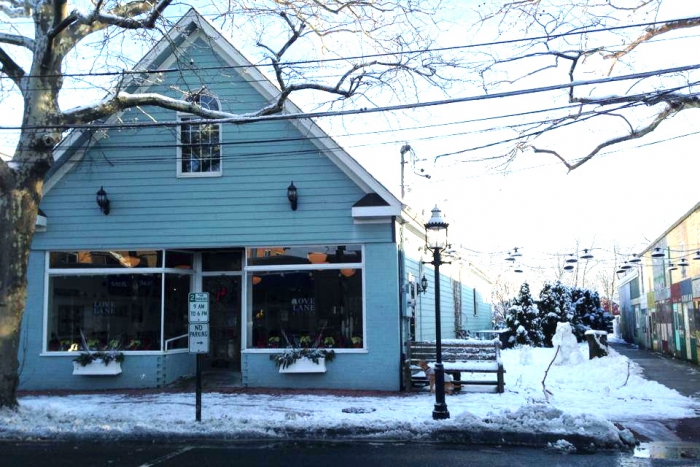2015 Dan’s Papers Literary Prize For Nonfiction Winner: Ghosts of Shopkeepers Past

Outside, golden forsythias bloom and an early spring breeze carries a pungent stench of fresh mulch and fertilizer. The long bleak winter is now a fleeting memory. As the quiver of new life breaks forth, I am reminded it is time to tend to my garden and prepare the soil. I make plans to search my crowded garage for my red kneepad and favorite garden gloves—the ones with the pink plastic dots that remind me of old-fashioned rolls of candy on paper. Tomorrow, I promise myself.
Today, I am inside the local history room of the Mattituck-Laurel Library. I am harvesting the past. A musty vanilla scent hovers as I spread aging books, old newspaper clippings, vintage postcards and fading photographs across a large table. I am reading the stories of Love Lane, which was once an old Indian footpath. Hundreds of years ago, Native Americans would drag their canoes from the shores of James Creek to Mattituck Creek along this shortcut and then paddle out to the Sound.
In the 1700s, early Mattituck settlers blocked this path for sheep to graze. In 1844 when the railroad line was established, the old footpath was opened and named Railroad Avenue East. Young suitors would stroll or ride their horses and wagons along the old Indian shortcut and linger north of the tracks beside the shore of Mattituck Creek. Once the word spread that this was the spot for some good old-fashioned romance, the name was changed to Lovers Lane and later shortened to Love Lane.
In Queens, where I was raised, the favorite make-out spot was along Astoria Park, down by the river. Couples would park their old beat-up cars by the bridge. Of course, this was when car seats were not separated by consoles; they were long and luxurious, like sofas. Many an evening, however, the romantic festivities were interrupted by a blinding flashlight piercing through a foggy window. “Move along,” a stern cop would say.
As I look at vintage photographs dated circa 1910, I find it hard to imagine such hormonal exuberance from these stern-faced, rigidly posed young adults. Then again, drunken wild selfies were not exactly the custom of those times. On a whim, I decide to play imaginary matchmaker. I study photos of employees of the Hudson Canning Factory, which was located down the block from Love Lane, next to the tracks. The gent I pick is wearing casual overalls and his eyes radiate the aura of a pre-James Dean rebel-archetype. In her photo, the young lady I choose is sporting a complicated Gibson puffy hairdo and a floor length checkered skirt. After a long day of cleaning squash and peeling tomatoes, they both deserve some fun. I picture an ink-black, star-clustered night as they ride a horse-drawn buggy to Mattituck Creek. He leans in close and whispers an inside work-related joke about their boss, or maybe something about canning. She laughs. The ice is broken and he folds his calloused hand over hers. They gaze at the eternal sky and listen to the echoes of the stars. They dream of their future. (This of course was before light pollution, when you could really see the stars.) Anyway, my work with them is done.
I discover some photos of old dance halls from those early 1900s. On Saturday nights, everyone could cut loose at either the second floor of the old library on Pike Street, or over at Reeve and Tuthill’s Apollo Hall, on the northwest corner of Love Lane. I can almost hear the jubilant piano roll music. I envision the women lacing up their corsets, and the men trading their farming overalls for vests and derbies. At first, everyone is stiff and shy. They stand against the wall waiting. As soon as the music cranks, the gents stroll over and choose a partner. Wild legs kick and fly as they dance the Peabody—named after the man whose belly was so rotund, the only way he could hold onto his partner was to dance sideways.
As time moves along, we hit the roaring twenties. The music of the Charleston and the Varsity Drag ring out from $25 Victrolas and local bands. Corsets are flung out the window and long hairdos are chopped to bobs. During the day, boys in knickers and girls with smocked dresses and ribboned hair flock to Dick Cox’s Ice Cream Parlor on Love Lane for a handful of jellybeans or gumdrops. On special occasions, they clutch their 15 cents, climb onto spinning fountain stools and wait for the white-aproned proprietor to ask, “What’ll yours be?”
Maybe they choose a Buster Brown with chocolate ice cream and pineapple sherbet and caramel, or maybe a Bull Moose with marshmallow cream and froufrou wafers. Outside the wavy glass window, a traveling hurdy-gurdy man performs with his trained bear and dancing monkey. Brand new Buicks line the street, purchased from W.C. Grabie’s. On the corner at the Octagon House, the Peconic Bay Impressionist Caroline Bell rents a room, and soon after, opens her blue-shuttered art studio off Love Lane and Sound Avenue.
I move forward to the next photo, dated 1935. Studebakers from Grabie’s now line the street. As I stare at the details, the sepia photo comes alive; an orange sherbet sun rises and an early morning haze lifts. One by one, the shopkeepers arrive and the sleeping lane in the old photo awakens. Lights are switched on, windows are cleaned, counters are polished, and porches are swept. The proprietors of Reeve and Hall Meat Market, Barkers Drugs and Soda, and H.C. Bohack open their doors and are ready for another day.
Seasons come and go. Every day lived evolves into a story that melds into the collective history of that era. I head outside to present day Love Lane with my photocopies and books in hand. I stroll by the heart-shaped street sign and down the speckled brick-red sidewalks. I pass the new toy store located in the Octagon House—which was once a bookstore, which was once a coffee shop, which was once a boarding house where Caroline Bell painted, and so on. As I pass the stores of 2015, the afternoon sky casts a golden glow on the narrow lane. Shadows form through the marbleized branches of the Sycamore trees, which twist and bend with time. The trees that line the street remember.
The ancient Celts believed that the dead do not live far away and remain attached to the places where they once lived and worked. Even Albert Einstein, who summered on Nassau Point in 1939, said, “Physicists believe the separation between past, present, and future is only an illusion.”
After years of tending to a store, fragments of a proprietor’s soul will always float within the old walls. The ghosts of shopkeepers-past still walk down Love Lane, and I am one of the ghosts. Even though I am still very much alive, my past is ghostlike. Whenever I reach the end of the street, my eyes always glance at the shop with the new sign. I never step inside. I know better. When the past and present collide in the physical world—like an ex-wife meeting the present wife—not much good usually comes of it.
My shop on Love Lane did not sell merchandise, like tinctures of iodine or sacks of flour. Nor did my previous store, which was located in a non-historic strip mall “up island.” The pizzeria owner at that strip mall once said, “The deli guy and I looked inside your store. It’s empty, yet people come to you. What do you sell—the invisible?”
Kahlil Gibran said, “Work is love made visible.” I sold my love of dance at my “up island” store for 12 years. I then moved to the North Fork where I taught ballet, tap and jazz at my studio on the corner of Love Lane and Pike for the next 17 years. Before my business, the Love Lane building housed a video rental store and way before that in 1850, the old Gildersleeve’s home and general store stood in its place. A vintage photo shows the hurdy-gurdy man’s costumed monkey dancing in the same spot where my studio would come to be.
Four years ago, I passed the Mattituck studio on to new owners. The time had come for me to stand back and allow that invisible creative spirit I had loved and nurtured within those walls to move forward.
Even though the stores and owners change through the years, couples in love still stroll down the lane. In the evenings, when the ochre glow of the last store light dims and the street is empty, the buildings breathe and dream their memories.
Tonight, a warm breeze carries a distant song of ragtime from an old dance hall. I linger at the end of Love Lane until the last strain of music fades.
***
This story is written by Collette Sewell, winner of the 2015 Dan’s Papers Literary Prize for Nonfiction (pictured below).

To find who who’ll win this year’s Emerging Young Writers Prize for Nonfiction, as well as the 2016 Dan’s Papers Literary Prize for Nonfiction competition, please come join us at the Dan’s Papers Literary Festival on Thursday, September 1, starting at 4 p.m. at the John Drew Theater at Guild Hall in East Hampton. For more information about the Gala Awards Ceremony and other events, visit DansLitPrize.com.



